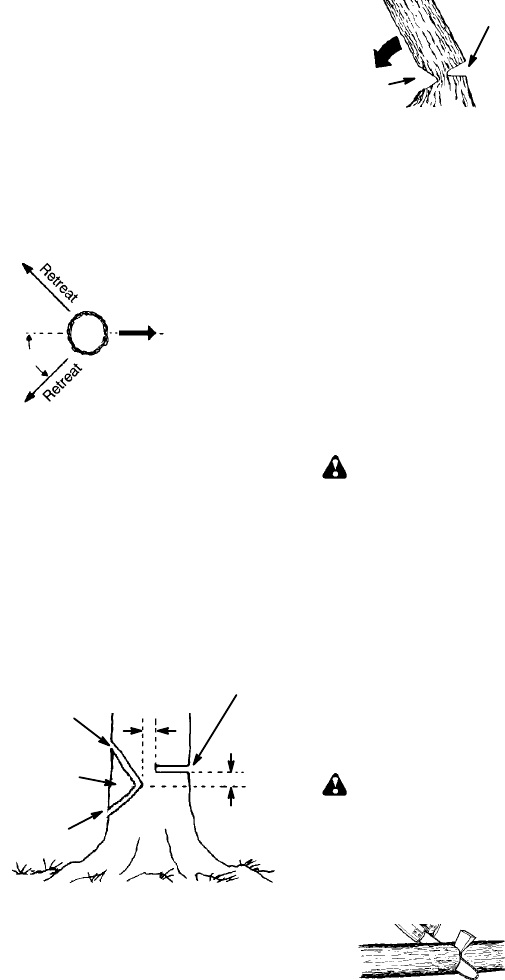
11
Natural conditions that can cause a tree to
fall in aparticular direction include:
S The wind direction and speed.
S The lean of the tree. The lean of a tree
might not be apparent due to uneven or
slopingterrain. Useaplum borleveltode-
termine the direction of tree lean.
S Weight andbranches on on e side.
S Surrounding trees and obstacles.
Look for decay and rot. Ifthetrunkis rotted,
it can snap and fall toward the operator.
Make sure thereis enough roomfor the t reeto
fall. Maintain a distance of
2-1/2 tree lengths
from the nearest person or other objects. En-
gine noise can drown out awarning call.
Remove dirt, stones, loose bark, nails, sta-
ples,andwirefromthetreewherecutsaret o
be made.
Direction of Fall
45_
Plan a clear retreat path
FELLING LARGE TREES
(15cmindiameterorlarger)
The notch methodis used tofelllargetrees.
Anotchiscutonthesideofthetreeint hede-
sired direction of fall. After a felling cut is
made on the opposite side of tree, the tree
will tend to fallinto the notch.
NOTCH CUT AND FELLING THE
TREE
S Make notch cut by cutting the top of the
notch first. Cutthrough
1/3of thediameter
ofthetree.Nextcompletethenotchbycut-
ting the bottom of the notch. See illustra-
tion. Once the notch is cut remove the
notch of wood from thetree.
Notch
First cut
Second cut
Final cut here. 5cm above
center of notch.
5cm
5cm
S After removing the wood from the notch,
make the felling cut on the opposite side of
thenotch.This i sdonebymakingacutabout
two inches higher than the center of the
notch. This will leave enough uncut wood
between thefellingcut a ndthenotch toform
a hing e. This hi nge willhelp p revent thetree
from falling in the wrong direction.
Opening
of felling
cut
Closing
of notch
Hinge holds tree on stump and helps
control fall
NOTE: Before felling cut is complete, use
wedges to open the cut when necessary to
controlthedirectionoffall. Toavoidkickback
or chain damage, use wood or plastic
wedges, butnever steel or iron wedges.
S Bealerttosignsthatthetreeisreadytofall:
cracking sounds, widening of the felling cut,
or movement in the upper branches.
S As treestartsto fall,stop saw,put itdown,
and get aw ay quickly on your plannedre-
treat path.
S DO NOT cut down apartially fallen treewith
your saw . Be extremely cautious with par-
tially fallen trees that may be poorly sup-
ported. When a tree doesn’t fall completely ,
set t hesawasideandpulldownthetreewith
a cable winch, block and tackle, or tractor.
CUTTING A FALLEN TREE
(BUCKING)
Bucking is the term used for cutting a fallen
tree to the desired loglength.
WARNING: Do not stand on the log
beingcut.Anypor tioncanrollcausinglossof
footing andcontrol.Do notstand downhillof
the log beingcut.
Important points
S Cut only one logat a time.
S Cut shattered wood very carefully; sharp
piecesofwoodcouldbeflungtowardoper-
ator.
S Use a sawhorse to cu t small logs. Never
allow another person to holdthe logwhile
cuttingandneverholdthelogw ithyourleg
or foot.
S Do not cut in an area where logs, limbs,
and rootsaretangled. D ragthe logsintoa
clear ar eabefore c uttingby pullingoutex-
posed and cleared logs first.
TYPES OF CUTTING USED FOR
BUCKING
WARNING:Ifsawbecom espinched
or hungin alog,don’t try toforceit out. You
can los econtrol oft hesaw resulting ininjury
and/or damage to the saw. Stop the saw ,
drivea wedgeof plastic orwood intothe cut
untilthesawcanberemovedeasily. Restart
thesawandcarefully reenterthecut. Donot
attemptt orestartyoursawwhenitispinched
or hung ina log.
Turn saw OFF and use a plastic or
wooden wedge to force cut open.


















